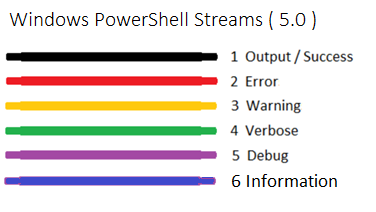捕获程序stdout和stderr以分隔变量
是否可以在一次运行中将stdout从外部程序重定向到外部程序的变量和stderr到另一个变量?
例如:
$global:ERRORS = @();
$global:PROGERR = @();
function test() {
# Can we redirect errors to $PROGERR here, leaving stdout for $OUTPUT?
$OUTPUT = (& myprogram.exe 'argv[0]', 'argv[1]');
if ( $OUTPUT | select-string -Pattern "foo" ) {
# do stuff
} else {
$global:ERRORS += "test(): oh noes! 'foo' missing!";
}
}
test;
if ( @($global:ERRORS).length -gt 0 ) {
Write-Host "Script specific error occurred";
foreach ( $err in $global:ERRORS ) {
$host.ui.WriteErrorLine("err: $err");
}
} else {
Write-Host "Script ran fine!";
}
if ( @($global:PROGERR).length -gt 0 ) {
# do stuff
} else {
Write-Host "External program ran fine!";
}
一个枯燥的例子,但我想知道这是否可能?
7 个答案:
答案 0 :(得分:32)
一种选择是将stdout和stderr的输出组合成一个流,然后过滤。
stdout中的数据将是字符串,而stderr生成System.Management.Automation.ErrorRecord对象。
$allOutput = & myprogram.exe 2>&1
$stderr = $allOutput | ?{ $_ -is [System.Management.Automation.ErrorRecord] }
$stdout = $allOutput | ?{ $_ -isnot [System.Management.Automation.ErrorRecord] }
答案 1 :(得分:10)
最简单的方法是使用stderr输出的文件,例如:
$output = & myprogram.exe 'argv[0]', 'argv[1]' 2>stderr.txt
$err = get-content stderr.txt
if ($LastExitCode -ne 0) { ... handle error ... }
我还会使用$ LastExitCode来检查本机控制台EXE文件中的错误。
答案 2 :(得分:8)
您应该使用带有-RedirectStandardError -RedirectStandardOutput选项的Start-Process。这个other post有一个如何做到这一点的很好的例子(从下面的帖子中抽样):
$pinfo = New-Object System.Diagnostics.ProcessStartInfo
$pinfo.FileName = "ping.exe"
$pinfo.RedirectStandardError = $true
$pinfo.RedirectStandardOutput = $true
$pinfo.UseShellExecute = $false
$pinfo.Arguments = "localhost"
$p = New-Object System.Diagnostics.Process
$p.StartInfo = $pinfo
$p.Start() | Out-Null
$p.WaitForExit()
$stdout = $p.StandardOutput.ReadToEnd()
$stderr = $p.StandardError.ReadToEnd()
Write-Host "stdout: $stdout"
Write-Host "stderr: $stderr"
Write-Host "exit code: " + $p.ExitCode
答案 3 :(得分:2)
这也是我用来重定向命令行的stdout和stderr同时在PowerShell执行期间仍然显示输出的替代方法:
PowerShell -File ".\FileName.ps1"
补充已经给出的东西只是另一种可能性。
请记住,这可能并不总是有效,具体取决于脚本的调用方式。从标准命令行而不是像这样的PowerShell命令行调用时,我遇到了-OutVariable和-ErrorVariable的问题:
$stdOutAndError = Invoke-Expression "$command 2>&1"
在大多数情况下似乎有效的替代方案是:
Write-Host $stdOutAndError不幸的是,在执行脚本期间,您将丢失输出到命令行,并且在命令返回后必须{{1}}使其成为“记录的一部分”(就像Jenkins批处理文件的一部分)跑)。不幸的是,它没有将stdout和stderr分开。
答案 4 :(得分:0)
另外,保留格式
cls
function GetAnsVal {
param([Parameter(Mandatory=$true, ValueFromPipeline=$true)][System.Object[]][AllowEmptyString()]$Output,
[Parameter(Mandatory=$false, ValueFromPipeline=$true)][System.String]$firstEncNew="UTF-8",
[Parameter(Mandatory=$false, ValueFromPipeline=$true)][System.String]$secondEncNew="CP866"
)
function ConvertTo-Encoding ([string]$From, [string]$To){#"UTF-8" "CP866" "ASCII" "windows-1251"
Begin{
$encFrom = [System.Text.Encoding]::GetEncoding($from)
$encTo = [System.Text.Encoding]::GetEncoding($to)
}
Process{
$Text=($_).ToString()
$bytes = $encTo.GetBytes($Text)
$bytes = [System.Text.Encoding]::Convert($encFrom, $encTo, $bytes)
$encTo.GetString($bytes)
}
}
$all = New-Object System.Collections.Generic.List[System.Object];
$exception = New-Object System.Collections.Generic.List[System.Object];
$stderr = New-Object System.Collections.Generic.List[System.Object];
$stdout = New-Object System.Collections.Generic.List[System.Object]
$i = 0;$Output | % {
if ($_ -ne $null){
if ($_.GetType().FullName -ne 'System.Management.Automation.ErrorRecord'){
if ($_.Exception.message -ne $null){$Temp=$_.Exception.message | ConvertTo-Encoding $firstEncNew $secondEncNew;$all.Add($Temp);$exception.Add($Temp)}
elseif ($_ -ne $null){$Temp=$_ | ConvertTo-Encoding $firstEncNew $secondEncNew;$all.Add($Temp);$stdout.Add($Temp)}
} else {
#if (MyNonTerminatingError.Exception is AccessDeniedException)
$Temp=$_.Exception.message | ConvertTo-Encoding $firstEncNew $secondEncNew;
$all.Add($Temp);$stderr.Add($Temp)
}
}
$i++
}
[hashtable]$return = @{}
$return.Meta0=$all;$return.Meta1=$exception;$return.Meta2=$stderr;$return.Meta3=$stdout;
return $return
}
Add-Type -AssemblyName System.Windows.Forms;
& C:\Windows\System32\curl.exe 'api.ipify.org/?format=plain' 2>&1 | set-variable Output;
$r = & GetAnsVal $Output
$Meta2=""
foreach ($el in $r.Meta2){
$Meta2+=$el
}
$Meta2=($Meta2 -split "[`r`n]") -join "`n"
$Meta2=($Meta2 -split "[`n]{2,}") -join "`n"
[Console]::Write("stderr:`n");
[Console]::Write($Meta2);
[Console]::Write("`n");
$Meta3=""
foreach ($el in $r.Meta3){
$Meta3+=$el
}
$Meta3=($Meta3 -split "[`r`n]") -join "`n"
$Meta3=($Meta3 -split "[`n]{2,}") -join "`n"
[Console]::Write("stdout:`n");
[Console]::Write($Meta3);
[Console]::Write("`n");
答案 5 :(得分:0)
起初,这个答案是在 another question 下发布的。
这两个问题类似,但是这里关注度更高,所以这里再发一个,或许可以为更多人提供解决方案。
使用Where-Object(别名是符号?)是一个显而易见的方法,但它有点太麻烦了。它需要大量代码。
这样不仅会花费更长的时间,还会增加出错的概率。
其实在PowerShell中有一种更简洁的方法可以将不同的流分离到不同的变量中(我偶然想到的)。
# First, declare a method that outputs both streams at the same time.
function thisFunc {
[cmdletbinding()]
param()
Write-Output 'Output'
Write-Verbose 'Verbose'
}
# The separation is done in a single statement.Our goal has been achieved.
$VerboseStream = (thisFunc -Verbose | Tee-Object -Variable 'String' | Out-Null) 4>&1
然后我们验证这两个变量的内容
$VerboseStream.getType().FullName
$String.getType().FullName
控制台上应显示以下信息:
PS> System.Management.Automation.VerboseRecord
System.String
'4>&1' 表示将verboseStream重定向到成功流,然后可以保存到一个变量中,当然你可以把这个数字改成2到5之间的任意数字。

如果你觉得我的方法还不错,请点击鼠标给我投票,非常感谢。
答案 6 :(得分:0)
如果您想从 PowerShell 脚本中获取任何内容并传递函数名称后跟任何参数,您可以使用 dot sourcing 来调用函数名称及其参数。
然后使用 James 的部分答案得到 $output 或 $errors。
.ps1 文件名为 W:\Path With Spaces\Get-Something.ps1,其中包含一个名为 Get-It 的函数和一个参数 FilePath。
两个路径都用引号括起来,以防止路径中的空格破坏命令。
$command = '. "C:\Path Spaces\Get-Something.ps1"; Get-It -FilePath "W:\Apps\settings.json"'
Invoke-Expression $command -OutVariable output -ErrorVariable errors | Out-Null
# This will get its output.
$output
# This will output the errors.
$errors
- 我写了这段代码,但我无法理解我的错误
- 我无法从一个代码实例的列表中删除 None 值,但我可以在另一个实例中。为什么它适用于一个细分市场而不适用于另一个细分市场?
- 是否有可能使 loadstring 不可能等于打印?卢阿
- java中的random.expovariate()
- Appscript 通过会议在 Google 日历中发送电子邮件和创建活动
- 为什么我的 Onclick 箭头功能在 React 中不起作用?
- 在此代码中是否有使用“this”的替代方法?
- 在 SQL Server 和 PostgreSQL 上查询,我如何从第一个表获得第二个表的可视化
- 每千个数字得到
- 更新了城市边界 KML 文件的来源?